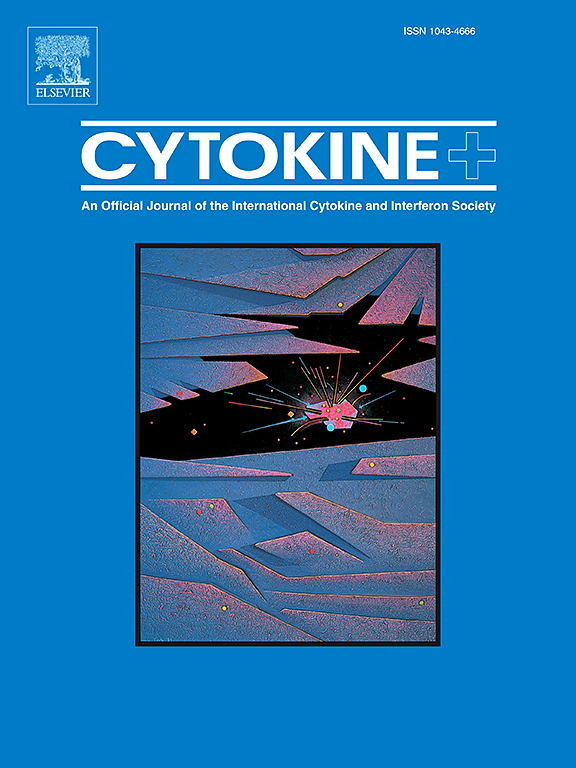Association between clinical activity score and serum sPD-1 and sPD-L1 levels during systemic glucocorticoid treatment for active moderate-to-severe thyroid eye disease
IF 3.7
3区 医学
Q2 BIOCHEMISTRY & MOLECULAR BIOLOGY
引用次数: 0
Abstract
Background
CD4+ T lymphocytes are key immune cells involved in orbital inflammation in thyroid eye disease (TED). Inhibition of their activity is important in treatment of TED, but effective drugs targeting these cells are lacking. The programmed cell death-1/programmed cell death ligand-1 pathway has been implicated in several T-cell-mediated diseases. Manipulation of this pathway with antagonists or agonists is an attractive therapeutic option. The role of soluble programmed cell death-1 (sPD-1) and soluble programmed cell death ligand-1 (sPD-L1) in regulation of this pathway is debated. This study aimed to investigate the involvement of sPD-1 and sPD-L1 in the pathogenesis of TED, focusing on their utility as novel biomarkers to evaluate disease severity and treatment response.
Methods
Thirty patients diagnosed with moderate-to-severe TED associated with Graves' disease were included. Blood samples were collected from patients before and 12 weeks after initiation of intravenous glucocorticosteroid (IVGC) treatment. Disease severity was assessed using the Clinical Activity Score (CAS) before and after IVGC treatment. Thyroid-stimulating hormone, free thyroxine, free triiodothyronine, thyroid-stimulating immunoglobulin, interleukin-6, sPD-1, and sPD-L1 levels were measured. Correlations between sPD-1, sPD-L1, and CAS before and after IVGC treatment were investigated. Serum concentrations of sPD-1 and sPD-L1 before and after IVGC treatment in patients with TED were compared with those in healthy controls (HCs). The changes in the tested protein concentrations upon IVGC treatment and their associations with clinical characteristics were investigated. Enzyme-linked immunosorbent assays were used to measure sPD-1 and sPD-L1 concentrations in peripheral blood serum.
Results
There was a positive correlation of moderate Spearman's rank strength between sPD-L1 and CAS before and after treatment, and a positive correlation between sPD-1 and sPD-L1. However, no correlation was observed between sPD-1 and CAS. Baseline serum levels of sPD-1 and sPD-L1 did not significantly differ between patients with TED and HCs. There were no correlations between changes in the levels of the tested molecules upon IVGC treatment and the analyzed clinical features. The decreases of sPD-1 and sPD-L1 levels after 12 weeks of IVGC treatment were not significant.
Conclusion
The positive correlation of moderate Spearman's rank strength between sPD-L1 and CAS before and after 12 weeks of treatment indicates that sPD-L1 is involved in the pathogenesis of TED. sPD-L1 may become an additional immunological biomarker to assess the disease activity and monitor the respond to treatment.
Although sPD-1 is reported in the literature to have an activating effect on lymphocytes, our study shows that sPD-1 may not play a significant role in the pathogenesis of TED, as its level does not differ significantly between the TED and HC groups and does not correlate with disease activity. Understanding the clinical value of sPD-1 and sPD-L1 is of great practical importance.
活动性中重度甲状腺眼病全身性糖皮质激素治疗期间临床活动评分与血清sPD-1和sPD-L1水平的关系
背景:CD4+ T淋巴细胞是参与甲状腺眼病(TED)眼眶炎症的关键免疫细胞。抑制它们的活性在治疗TED中很重要,但目前缺乏针对这些细胞的有效药物。程序性细胞死亡-1/程序性细胞死亡配体-1通路与几种t细胞介导的疾病有关。用拮抗剂或激动剂操纵这一途径是一种有吸引力的治疗选择。可溶性程序性细胞死亡-1 (sPD-1)和可溶性程序性细胞死亡配体-1 (sPD-L1)在这一途径调控中的作用尚存争议。本研究旨在探讨sPD-1和sPD-L1在TED发病机制中的作用,重点关注它们作为评估疾病严重程度和治疗反应的新型生物标志物的效用。方法:入选30例诊断为中重度TED合并Graves病的患者。在静脉注射糖皮质激素(IVGC)治疗前和开始后12周采集患者血样。使用临床活动评分(CAS)评估IVGC治疗前后的疾病严重程度。测定促甲状腺激素、游离甲状腺素、游离三碘甲状腺原氨酸、促甲状腺免疫球蛋白、白细胞介素-6、sPD-1、sPD-L1水平。探讨IVGC治疗前后sPD-1、sPD-L1与CAS的相关性。将TED患者IVGC治疗前后血清sPD-1和sPD-L1浓度与健康对照(hc)进行比较。研究了IVGC治疗后检测蛋白浓度的变化及其与临床特征的关系。采用酶联免疫吸附法测定外周血血清中sPD-1和sPD-L1的浓度。结果:治疗前后sPD-L1与CAS中度Spearman等级强度呈正相关,sPD-1与sPD-L1呈正相关。sPD-1与CAS无相关性。基线血清sPD-1和sPD-L1水平在TED和hcc患者之间无显著差异。在IVGC治疗后,被测分子水平的变化与所分析的临床特征之间没有相关性。经IVGC治疗12周后,sPD-1和sPD-L1水平下降不显著。结论:治疗前后12周sPD-L1与CAS中度Spearman's rank强度呈正相关,提示sPD-L1参与了TED的发病机制。sPD-L1可能成为评估疾病活动性和监测治疗反应的额外免疫生物标志物。虽然文献报道sPD-1对淋巴细胞有激活作用,但我们的研究表明sPD-1在TED的发病机制中可能没有显著作用,因为其水平在TED组和HC组之间没有显著差异,也与疾病活动性无关。了解sPD-1和sPD-L1的临床价值具有重要的现实意义。
本文章由计算机程序翻译,如有差异,请以英文原文为准。
求助全文
约1分钟内获得全文
求助全文
来源期刊

Cytokine
医学-免疫学
CiteScore
7.60
自引率
2.60%
发文量
262
审稿时长
48 days
期刊介绍:
The journal Cytokine has an open access mirror journal Cytokine: X, sharing the same aims and scope, editorial team, submission system and rigorous peer review.
* Devoted exclusively to the study of the molecular biology, genetics, biochemistry, immunology, genome-wide association studies, pathobiology, diagnostic and clinical applications of all known interleukins, hematopoietic factors, growth factors, cytotoxins, interferons, new cytokines, and chemokines, Cytokine provides comprehensive coverage of cytokines and their mechanisms of actions, 12 times a year by publishing original high quality refereed scientific papers from prominent investigators in both the academic and industrial sectors.
We will publish 3 major types of manuscripts:
1) Original manuscripts describing research results.
2) Basic and clinical reviews describing cytokine actions and regulation.
3) Short commentaries/perspectives on recently published aspects of cytokines, pathogenesis and clinical results.
 求助内容:
求助内容: 应助结果提醒方式:
应助结果提醒方式:


